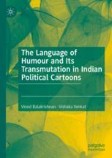Search
Search Results
-
Performance of Humour in Political Cartoons
This chapter problematises the dynamics of political humour. Beginning with the hypothesis that language is inherently violent and diabolic in...
-
Humour and the Many Worlds of Nigerian Political Cartoons
Political cartoons are known to evoke humour, partially through the creation of caricatures, which are deliberate graphic distortions of material...
-
The Language of Humour and Its Transmutation in Indian Political Cartoons
This book develops a model to examine the language of humour, which is multimodal and accounts for the possibility of transmutation of humour as it...
-
Metaphors of Intolerance: A Comparative Analysis between the Speeches and Cartoons of Jair Bolsonaro and Donald Trump on Immigration
In this chapter, we develop a comparative analysis between metaphors in the speeches of Jair Bolsonaro and Donald Trump on immigration. Firstly, we...
-
Application of the Model
In this chapter the study applies the integrated model to the cartoons which were recommended for deletion by the Thorat Committee. The common...
-
Understanding Humour
The introductory chapter reviews the literature on humour theories. While the traditional theories of humour attend to the competence of humour, this...
-
Language, Context and Operation of Humour
The concluding chapter summarises the need for a study of humour in political cartoons. Discussing the pros and cons of the model, the section also...
-
Pop Goes Fang Fang?
Besides official news media reports, social media posts, defamatory “pseudo-academic” attacks, and personal attacks criticizing Wuhan Diary, another...
-
Paralanguage in the Translation of Children’s Graphic Novels into Arabic: Jeff Kinney’s Diary of a Wimpy Kid
Graphic novels are marketed as helpful for reluctant young readers. The supplementation of text with visual stimuli as part of a multimodal narrative...

-
A Communicative Framework of Humour
In this chapter the study explores the communicative framework of humour through Jakobson and Barthes. The chapter begins with an introduction to...
-
Syrian Parents’ Strategies in Language Maintenance
Chapter 3 has established that Syrian parents in Malaysia value the Malay language but their primary emphasis is on learning English for education,...
-
Metaphor: The Rhetorical Frame of Humour
In this chapter the second stage of the model is emphasized through metaphor as a measuring tool for evaluating the transgression of humour. With a...
-
Sha** Amazigh Identity: The Case of the Netherlands
Moroccan emigration to the Netherlands started in the 1960s with individual workers reaching the country, mostly via France and Belgium, and...
-
Children’s Literature: Exploring Intertextual Relationships
Texts carry traces of the language, social and cultural characteristics of both the period in which they were written and the period before them....

-
Exploring Dementia in Children’s Literature: An Interactive Exhibition
It is estimated that 55 million people live with dementia around the world, a number that could triple by 2050 (Alzheimer’s Society, 2023). Dementia...

-
Afterword
As noted in the introductory chapter, this collection of chapters provides candid and in-depth analyses of the relationship between discourse and...
-
Levels of Success with English and Learning Conditions: Same Opportunities?
Language education aims at giving the same opportunities to all students irrespective of their background. Unfortunately, large-scale studies have...
-
Moomins Take the Floor. Finnish Trolls in Contemporary Mass Social (Media) Events
Tove Jansson (1914–2001) was an outstandingly talented Finnish-Swedish artist, recognized worldwide mostly as the creator of the Moomins. Although...
-
“Shamuz, Shamuz, Everything Is with Shamuz”—Making Sense of Humour Theory and Stylistic Enquiry: An Overview
One of the famous examples of humour causation by Henri Bergson, a nineteenth-century French philosopher of humour, is that of a man running in the...
-
The Rasch Model in Humour Research
This study examines the object-subject (stimulus-resipient) trap in the study of humour, whereby humour is perceived as arising either from some...
